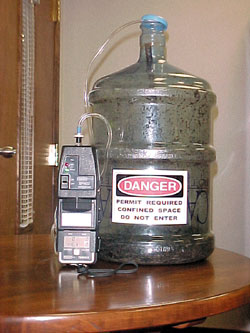Summary Statement
A description of a demonstration that helps get across the dangers of confined spaces, which involves creating a confined space in a 5 gallon cooler jug that is filled with mulch, leaves, lumber and water.
November 2000
| Reprinted with permission © 2000, Stevens Publishing Corporation. |
Just how will
you get the full gist of your point across?

Developing effective training that actually means something to people is a problem professionals in many fields have to face. With the ready availability and low cost of TVs and VCRs and the growing number of vendors with huge selections of tapes, much of our "training" has become "Watch this," followed by "Any questions?"
Even in those training programs that make proper use of video as a teaching aid, there is still difficulty in getting the full effect of the lesson across to the participants. With the advent of spectacular special effects, computer graphics, and amazing makeup and costuming, we are exposed to fully believable invasions of the planet, angels descending to earth, and even the presence of leprechauns and fairies under every leaf. Even with the use of high-impact videos, our audiences have become a mixture of total desensitization to the gore and an "It's all just images on the tube and can't happen to me" apathy.
|
We put together a low-cost, tabletop demonstration piece that amazed our last two confined-space classes. |
We ran into just this problem with our confined space training program. The videos we use as supplements are very well done. For our fire brigade, we have outside instructors come on site and do an excellent job of classroom instruction. The participants are then taken outside, where they practice access and rescue. But how do you get the participants to understand the full range of dangers associated with a confined space?
In many cases, a person can see the danger, so getting the idea across is easy. Tapered floors, material hanging overhead, and the need to crawl into and around in a space are obvious hazards. But how can you get people to understand that the pit or vault they just opened, that only has some leaves and grass lying in the bottom, is dangerous and could possibly kill them? We have found one answer. We went back to the old way (Remember when we didn't have videos and computers?): the demonstration.
The Recipe
We put together a low-cost, tabletop demonstration piece that amazed our last two confined space classes. Here is all it took:
- Cooler jug (5-gallon size), empty, with lid (courtesy of a vendor who was convinced I'm crazy and would do just about anything to humor me)
- 3 to 5 cups of common mulch (I got mine out of one of my wife's flower beds)
- 1 handful of leaves ripped off an unsuspecting, non-poisonous bush
- 1 piece of ¼" by 18" rebar from a local lumber yard (this is the only thing I actually had to pay for)
- 1 cup of water
- Dump everything into the jug, shake it a little, and cap it off
- Allow to sit for a while ("a while" depends on weather; it works faster in warmer weather).
The first time we used the unit was after it had sat in a garage for about two months in the North Carolina summer. During the confined space portion of a new hire orientation, we uncapped the bottle and dropped the probe from a sampling pump down to just above the mulch level. Almost immediately, every red light and alarm in the gas meter went off. Once the reading stabilized, we had readings of 0.8 percent oxygen and 4 percent LEL.
The second use was one month later during a fire brigade training session on confined space rescue. At that time, the oxygen level had dropped even lower, to 0.3 percent, and LEL had risen to 8 percent (LEL is assumed to be methane). These employees had prior training in confined space entry, had performed sampling, and knew all of the proper procedures to follow. They were amazed at the readings. A lively discussion followed on how the readings got so low.
There are all kinds of strange but attention-grabbing and effective ideas out there that can be put together with little cost and effort. |
While the group conducted all of the proper air sampling prior to entry, many people did not realize that simple decomposition could cause a hazardous atmosphere. Rapid oxidation is burning (a fire), while slow oxidation is rusting or rotting. Both methods use, and need, oxygen. It's just that one type of oxidation uses it a lot faster and happens in a much more visual and dramatic manner.
The demo unit is cheap to make, very effective, and easy to store. An added bonus is that the terrarium on top of the file cabinet makes a very interesting conversation piece.
We have developed other homemade demonstration pieces that have been very effective parts of our training program. Something does not have to be pre-made and purchased to be effective. If you do not have any ideas, talk to some of your people. There are all kinds of strange, weird, but attention-grabbing and effective ideas out there that can be put together with little cost and effort. However, the effort will add a whole new dimension to your training efforts.
Mark Schau, M.S., CSP, is Supervisor, Safety & Plant Protection for PPG Industries Fiber Glass Products in Shelby, N.C. He can be reached at schau@ppg.com.


